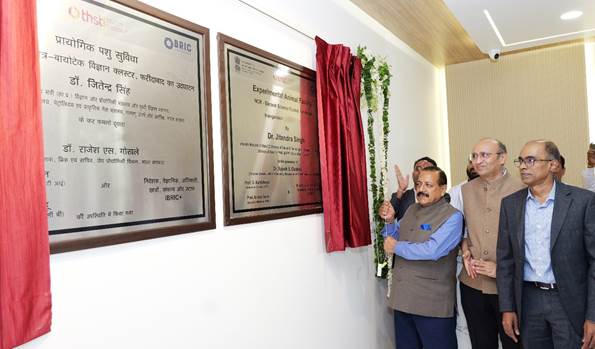Union Minister Dr. Jitendra Singh inaugurated Asia’s first health research-related “Pre-clinical Network Facility” under the Coalition of Epidemic Preparedness Innovations (CEPI) at the Regional Centre of Biotechnology, Faridabad. This facility operates under the aegis of the “Translational Health Science & Technology Institute” (THSTI).
Global Recognition and Capabilities
CEPI has selected BRIC-THSTI as a pre-clinical network laboratory due to its capability to handle BSL3 pathogens. This makes it the 9th such network laboratory globally and the first in Asia, with others located in the USA, Europe, and Australia. The Experimental Animal Facility at THSTI is one of the largest in the country, with a housing capacity of about 75,000 mice, including immune-compromised mice and other species such as rats, rabbits, hamsters, and guinea pigs.
New Repository for Microbial Cultures
Dr. Jitendra Singh also inaugurated the “Genetically Defined Human Associated Microbial Culture Collection (Ge-HuMic) Facility.” This facility will act as a “repository” for providing microbial cultures to research institutes, universities, and industries for research and development. It will serve as a Nodal Resource Center, fostering national and international collaborations between academic institutions, hospitals, and industry. It will also be a repository of genetically characterized specific pathogen-free animals for researchers.
THSTI’s Role in Vaccine Development and Research
The Translational Health Science and Technology Institute (THSTI), part of the Biotechnology Research and Innovation Council (BRIC), under the Department of Biotechnology, Ministry of Science and Technology, has facilitated numerous agreements with the private sector for vaccine development and research on diseases like Nipah Virus and Influenza. The institute supports innovative research, tests drug and vaccine candidates, identifies disease biomarkers, and fosters research collaborations across disciplines and professions.
Milestones and Achievements
Speaking at the 14th Foundation Day of THSTI, Dr. Jitendra Singh reflected on the institute’s journey since its inception. He credited Dr. M.K Bhan for his foundational efforts and highlighted the institute’s achievements, particularly during the COVID-19 pandemic, which underscored its importance.
Support and Future Directions
The Minister appreciated the Department of Biotechnology’s progress despite limited resources and assured continued support for the department’s infrastructure needs. He emphasized THSTI’s crucial role during the COVID-19 pandemic and in vaccine development, noting India’s recognition as a frontline nation in preventive healthcare.
Addressing Contemporary Health Challenges
Dr. Jitendra Singh, an endocrinologist, discussed the burden of lifestyle-related metabolic diseases in India and reiterated Prime Minister Modi’s vision of a TB-free India. He also highlighted THSTI’s development of Nipah monoclonal antibodies and the implementation of WHO-recommended kangaroo-mother care practices to reduce infant mortality.
Notable Attendees
The event was attended by Dr. Rajesh Gokhale, Secretary of DBT, Dr. K. Shrinath Reddy, former president of the Public Health Foundation of India, and Dr. Kathikeyan, Director of THSTI.
Multiple Choice Questions (MCQs):
- Who inaugurated Asia’s first health research-related “Pre-clinical Network Facility” under CEPI?
- A) Dr. M.K Bhan
- B) Dr. Rajesh Gokhale
- C) Dr. K. Shrinath Reddy
- D) Dr. Jitendra Singh
- Answer: D) Dr. Jitendra Singh
- Where is the newly inaugurated “Pre-clinical Network Facility” located?
- A) New Delhi
- B) Mumbai
- C) Faridabad
- D) Bangalore
- Answer: C) Faridabad
- What is the capacity of the Experimental Animal Facility at THSTI?
- A) 50,000 mice
- B) 75,000 mice
- C) 100,000 mice
- D) 150,000 mice
- Answer: B) 75,000 mice
- What is the purpose of the “Genetically Defined Human Associated Microbial Culture Collection (Ge-HuMic) Facility”?
- A) To serve as a hospital
- B) To provide microbial cultures for research and development
- C) To develop vaccines for COVID-19
- D) To store medical equipment
- Answer: B) To provide microbial cultures for research and development
- Which organization is THSTI a part of?
- A) Indian Council of Medical Research (ICMR)
- B) Biotechnology Research and Innovation Council (BRIC)
- C) National Institute of Health (NIH)
- D) Indian Space Research Organisation (ISRO)
- Answer: B) Biotechnology Research and Innovation Council (BRIC)
- What significant role did THSTI play during the COVID-19 pandemic?
- A) Developed new surgical techniques
- B) Developed COVID-19 vaccines and received emergency use authorization in India
- C) Conducted nationwide surveys
- D) Built new hospitals
- Answer: B) Developed COVID-19 vaccines and received emergency use authorization in India
